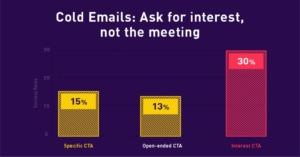Prospecting via Email? You Need to Nail These 3 Things
Email prospecting is one of the simplest and most widely-used strategies for generating sales leads. It’s also one of the most overused and abused. If you’re not doing it right, it can not only be a colossal waste of time but can also damage your personal and corporate brand.
About 320 billion emails are sent and received daily around the world, increasing at a rate of about four percent every year. That means both customers and their corporate firewalls are extremely particular about which messages they interact with. In fact, according to Hubspot, the average email open rate is only a mere 20.94% across all industries and ISPs are increasingly cracking down on which messages make it past their spam filters.
So when it comes to email prospecting, how can you ensure you break through the noise, hook prospects in, and move your deals forward? Here are three critical factors you need to focus on.
1. Deliverability
If you think every email you send to a prospect lands in their inbox, think again!
Data tells us that email deliverability (i.e. when the message actually lands in the recipient’s inbox) is on the decline, even for top-rated CRMs and marketing platforms. As of April 2022, the average email deliverability rate was 84.2%, a 4.7% decrease from the same period a year prior.
Though you’re likely using a tried and tested platform or corporate CRM to send your prospecting emails, optimizing the email deliverability of your personal inbox is still critical to the success of your efforts.
Here are three simple ways to do that:
1. Check your company’s domain health. Use an application like MX toolbox to validate key factors of your email domain like your IP blacklist status, DNS lookup, email health report, and more. If MX toolbox flags your company’s domain for any reason, your email deliverability is likely to suffer so be sure to advise your IT department if that happens.
2. Use an “inbox warmer”. If you’re using a newer domain to send emails, consider using an inbox warmer like Mailshake or Woodpecker. These platforms use bots to kickstart email conversations between your domain/email and other high-reputation inboxes on their end to improve domain reputation and email deliverability rates. By warming your inbox you substantially lessen the chances of being blacklisted or being stopped by spam filters.
3. Avoid sending images, videos, or links in the first 1-3 emails to new prospects (including within your email signature). All of these content types are extremely flaggable by spam filters for various reasons. As an example, images are seen by spam filters as abnormal blank space, especially when alt text isn’t included. Links are also seen as suspicious when not directed to the highest-quality sites. So to be safe, stay away from the ‘fun’ additives until later in your prospecting motions.
2. Subject Lines
Outside of deliverability, your subject lines are the most important element of your emails. Subject lines are the receiver’s first impression of your message and if they fall flat, your emails quickly join thousands of others in the ‘sea of sameness’, sinking in the archive for eternity.
To avoid the abyss, here are three data-driven tips for crafting subject lines that entice your prospects to read more:
1. Keep it simple and say no to clickbait. Science tells us that overly enticing (and frankly ridiculous) subject lines like “EARN $50,000 IN TWO DAYS WITH NO WORK 😱💥💸” can reduce read rates by nearly 9%. While data from top-rated email marketing platforms including Mailchimp tell us concise subject lines, that clearly indicate the purpose of the message, are your best bet.
2. Personalization is key. Research shows that 72% of consumers say they only engage with personalized messaging and personalizing your subject lines can drive big performance boosts. Thankfully, there are multiple ways to make subject lines feel uniquely crafted. From including the first name of your prospect to adding relevant trigger words like their company name, department, manager’s name, or other interests – the opportunities are bountiful.

3. Optimize the “preheader”. If you look at your inbox, you’ll notice that email notifications include not only the subject line but also the 8-10 words following it (also known as the preheader). Preheaders are a modern version of the old-school “Johnson Box”, a strategy used in direct response copywriting to get ‘sneak peeks’ of subject matter included in sales letters. Don’t ignore this! The goal of the preheader is to entice the reader to keep reading. So when it comes to prospecting, use the preheader to provide more context as to what the prospect will get out of the email. For example:
Subject line: Mentorship for senior {{COMPANY}} AEs
Preheader: Hi {{firstname}}, Research shows that retention of senior AE’s is on the decline.
Subject line: Boosting {{DEPARTMENT}} team member morale during crunch time
Preheader: Hi {{firstname}}, with the pressure to perform at an all-time high, fast-growing companies are struggling to their team’s spirits up.
3. Calls To Action
Too many sellers don’t pay enough attention to what they want their prospects to actually DO after they finish reading their emails. In other words, not laying out a clear CTA (call to action) or using one that introduces too much friction can cause your click-through and conversion rates to plummet.
In the past, I’ve spoken about how asking customers to take actions that are too big, complex, or commitment-laden can scare them out of taking action.
Bonus Video: Are Your CTA’s Scaring Your Customers Away?
Gong analyzed over 300,000 emails to identify which type of prospecting CTA’s resulted in a successfully booked meeting within 10 days.
1. Specific CTAs: Asking for a meeting and providing a specific date and time. Example: Are you available to meet on Tuesday at 4pm?
2. Open-ended CTAs: Asking for a meeting without all the specifics. Example: Would you be available to meet sometime next week?
3. Interest-based CTAs: Asking the prospect to simply confirm their interest in taking the next step. Example: Are you interested in learning more about {INSERT THING}.
The data showed that starting with interest-based CTAs especially when dealing with cold prospects was the winner! Even though your ultimate goal is to book a discovery call, intro presentation, or pitch meeting, using those as the CTA in your initial outreach will likely trigger your customer’s sense of reactance (i.e. psychological avoidance) even if that wasn’t your intention.

On the other hand, interest-based CTA’s like, “Are you interested in learning more about the connection between network security and revenue retention?”, are more likely to result in your customer committing to the next step because it simply isn’t as scary.
Though email prospecting continues to get more challenging year after year, it’s still possible to engage new leads and move opportunities forward via the good ol’ inbox! By taking advantage of email optimization tools, crafting your subjects and heading strategically, and landing your CTA’s at the right level, you’ll be well on your way to booking more intro meetings.
Watch the Webinar On Demand: Advanced Email Prospecting with Florin Tatulea and David Priemer
We promise never to send you junk or share your email! Just helpful sales insights.






